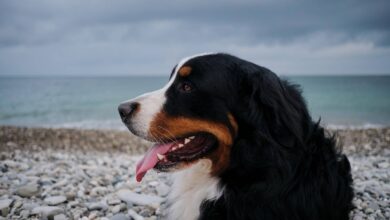
The sun is out, the water is sparkling, and you glance over at your fluffy Bernedoodle, wondering, “Would they enjoy a swim?” It’s a great question, and the answer isn’t as simple as a yes or no.
Yes, many Bernedoodles can be excellent swimmers and absolutely love the water. But for others, it’s a genetic lottery that might leave them preferring to be a poolside supervisor. This uncertainty comes from their unique parentage: the water-loving Poodle and the land-loving Bernese Mountain Dog.
As a long-time dog owner, I’ve seen both water-loving pups and those who won’t dip a toe. This guide is built on experience and thorough research to help you navigate either situation. We’ll dive into how to introduce your dog to water safely, the crucial post-swim care to prevent health issues, and what to do if your doodle decides they’re a dedicated landlubber.

Headline
- 1 The Genetic Lottery: Poodle vs. Bernese Mountain Dog Heritage
- 2 How to Safely Introduce Your Bernedoodle to Water
- 3 Is Swimming Good Exercise for Bernedoodles?
- 4 Must-Know Safety Risks Before You Dive In
- 5 The Essential Post-Swim Care Routine (Don’t Skip This!)
- 6 What If My Bernedoodle Hates Water?
- 7 Frequently Asked Questions
- 8 Conclusion: So, Should Your Bernedoodle Swim?
The Genetic Lottery: Poodle vs. Bernese Mountain Dog Heritage
To understand your Bernedoodle’s behavior, we need to look at their family tree. They are a direct mix of two very different breeds when it comes to water.
The Water-Lover Gene: The Poodle’s History
The Poodle is a quintessential water dog. They were originally bred in Germany as waterfowl retrievers, tasked with jumping into lakes to fetch game for hunters. Their iconic haircut was even developed for function, not just fashion, keeping their joints and core warm while allowing for free movement in the water. Their curly, water-resistant coat and athletic build make them natural-born swimmers.
The Mountain Dog Instinct: The Bernese’s Background
On the other paw, the Bernese Mountain Dog was bred to be a general-purpose farm and mountain dog in the Swiss Alps. Their job involved pulling carts, herding livestock, and acting as loyal watchdogs—all land-based activities. Their heavy double coat is fantastic for staying warm in snow but can become dangerously waterlogged and heavy in a lake, weighing them down.
What This Means for Your Bernedoodle’s Coat and Temperament
Your Bernedoodle inherits a mix of these traits. Some may get the Poodle’s love for water and a lighter, more wavy coat that does well with swimming. Others might inherit the Bernese’s cautious nature and a denser undercoat that makes swimming more work. Ultimately, their individual personality and early experiences will play the biggest role.
How to Safely Introduce Your Bernedoodle to Water
If you want to give your Bernedoodle the best chance to love swimming, a gentle and positive introduction is everything. A bad first experience can create a lifelong fear.
Start at the Right Time (and Age)
You can introduce a puppy to water after they have completed their full course of puppy vaccinations. Start in a very calm, shallow body of water where they can stand comfortably, like the edge of a quiet lake or a kiddie pool.
Choose a Calm, Safe Location
Avoid places with strong currents, big waves, or steep drop-offs. The goal is to build confidence, not create panic. A peaceful shoreline where they can walk in at their own pace is ideal.
Use Positive Reinforcement: Toys, Praise, and Treats
Make the water a fun place to be! Toss a favorite floating toy a short distance. Use an excited, encouraging tone and offer plenty of praise and high-value treats for any interaction with the water, even if it’s just getting their paws wet.
Invest in a Canine Life Vest (Especially at First)
A well-fitting canine life vest is a fantastic safety tool. It gives your dog extra buoyancy and confidence. Look for one with a handle on the back, which allows you to easily guide them in the water or lift them out quickly if needed.
The Golden Rule: Never Force Them
This is the most important rule. Never throw your dog into the water or drag them in. This will only create fear and a negative association. Let them explore at their own pace. If they decide it’s not for them, respect that choice.
Is Swimming Good Exercise for Bernedoodles?
For Bernedoodles that enjoy it, swimming is one of the best forms of exercise you can offer.
A Perfect Low-Impact Workout for a Large Breed
Unlike running, which can be hard on the joints, swimming is a fantastic low-impact exercise. The water supports your dog’s weight, allowing them to build muscle and cardiovascular health without stressing their frame.
Benefits for Joint Health and Weight Management
Because they are a large breed, Bernedoodles can be prone to joint issues like hip dysplasia and elbow dysplasia. Swimming is often recommended by vets to help maintain a healthy weight and strengthen the muscles around the joints, which provides better support.
A Note From Our Team: Always Consult Your Vet
Before starting any new, strenuous exercise routine like swimming, it’s always a good idea to consult your veterinarian. They can confirm your dog is in good health and give you the green light, especially if your pet has any pre-existing health concerns.
Must-Know Safety Risks Before You Dive In
A fun day can turn dangerous if you aren’t aware of the risks. Keeping your dog safe should always be the top priority.
Water Quality: The Hidden Danger of Blue-Green Algae
Be extremely cautious about letting your dog swim in stagnant ponds or lakes, especially during hot weather. These can contain blue-green algae (cyanobacteria), which produces toxins that are highly dangerous and can be fatal to dogs if ingested. If the water looks like pea soup or has a scummy surface, stay out.
Know the Signs of Water Intoxication
While rare, dogs can suffer from water intoxication by swallowing too much water while playing fetch. This can lead to a dangerous drop in electrolytes. Signs include loss of coordination, lethargy, bloating, and vomiting. If you notice these symptoms after a swim, contact your vet immediately.
Prevent Exhaustion and Drowning Risk
Even natural swimmers can get tired. Keep swimming sessions short to start and call your dog out for frequent rest breaks. Remember that even a dog that loves swimming is at risk of drowning if they become exhausted or panicked.
The Essential Post-Swim Care Routine (Don’t Skip This!)
Your job isn’t over when your dog gets out of the water. Proper post-swim care is non-negotiable to prevent common health problems.
Step 1: Rinse the Coat to Remove Chlorine or Salt
If your dog swam in a pool or the ocean, give them a thorough rinse with fresh, clean water. Chlorine can dry out their skin and coat, while salt water and bacteria from lakes can cause irritation.
Step 2: Thoroughly Dry Their Coat to Prevent Hot Spots
A Bernedoodle’s thick undercoat can trap moisture against the skin for hours, creating the perfect environment for painful bacterial infections known as hot spots. Towel dry your dog as much as possible, and then use a high-velocity pet dryer if you have one to ensure their coat is dry right down to the skin.
Step 3: Clean and Dry Their Ears to Prevent Painful Infections
Bernedoodles’ floppy ears trap moisture, making them highly susceptible to ear infections. After every swim, use a vet-approved ear cleaning solution to flush out any trapped water and debris. Gently wipe the outer ear canal with a cotton ball—never use a Q-tip. This single step can save your dog a lot of pain and save you a trip to the vet.
What If My Bernedoodle Hates Water?
So you followed all the steps, and your Bernedoodle has officially decided they are not a “water dog.” That’s completely okay!
Respect Their Preference and Find Alternatives
The best thing you can do is respect their choice. Forcing the issue will only cause them stress. There are plenty of other ways to have fun and stay active together.
Fun Ways to Keep Cool Without a Full Swim
On hot days, your doodle can still cool off. Many dogs who hate swimming love running through a sprinkler, splashing in a shallow wading pool, or just lying on a cooling mat in the shade.
Other Great Low-Impact Exercises They Might Enjoy
You can still get the benefits of low-impact exercise on dry land. A brisk walk during the cooler parts of the day, playing with puzzle toys, or a gentle game of fetch in a grassy park are all fantastic options.
Frequently Asked Questions
At what age can a Bernedoodle puppy start swimming?
It’s best to wait until your Bernedoodle puppy has completed their full series of vaccinations, which is typically around 16-18 weeks of age. Their first introduction to water should be in a calm, very shallow area where they can stand comfortably, ensuring the experience is positive and not frightening.
Do Bernedoodles need life jackets to swim?
While many Bernedoodles are capable swimmers, a life jacket is always a recommended safety measure. It provides extra buoyancy and confidence, especially for puppies, seniors, or dogs new to the water. A vest with a top handle is particularly useful for guiding your dog or lifting them out of the water in an emergency.
How do I clean my Bernedoodle’s ears after swimming?
Cleaning their ears after every swim is crucial to prevent infections. Use a veterinarian-approved ear cleaning solution to flush out each ear. Then, gently wipe the outer ear canal and flap with a clean cotton ball to remove moisture and debris. Never insert a Q-tip into the ear canal.
Will a Bernedoodle’s coat get matted from swimming?
Yes, a Bernedoodle’s coat can easily become matted after swimming if not cared for correctly. The combination of water and their thick, curly hair creates the perfect condition for tangles. To prevent this, always rinse their coat thoroughly with fresh water after a swim and dry it completely, brushing it out as it dries.
Conclusion: So, Should Your Bernedoodle Swim?
Whether your Bernedoodle takes to swimming like a Poodle or prefers to spectate like a Bernese Mountain Dog, what matters most is their safety and happiness.
By understanding their unique genetic background, introducing them to water with patience and positivity, and following crucial safety and after-care routines, you are empowered to make the best decision for your furry friend. The goal is always a happy, healthy dog—whether they’re a dock diver or a patio lounger.




